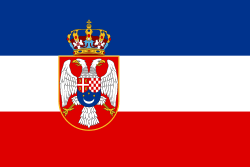Flag of Yugoslavia
 | |
| Use |
National flag |
|---|---|
| Proportion | 1:2 |
| Adopted | January 31, 1946[1] |
| Design | Three equal horizontal bands of blue (top), white and red, charged with a gold-bordered red star in the center |
| Designed by | Đorđe Andrejević-Kun |
|
Variant flag of Yugoslavia | |
| Use |
Civil and state ensign |
| Proportion | 2:3 |
| Adopted | March 21, 1950[2] |
| Design | Three equal horizontal bands of blue (top), white and red, with a gold-bordered red star at the flag's center |
|
Variant flag of Yugoslavia | |
| Use |
Naval ensign |
| Proportion | 2:3 |
| Adopted | June 6, 1949[3] |
The flag of Yugoslavia was the official flag of the Yugoslav state from 1918 to 1992. The flag's design and symbolism are derived from the Pan-Slavic movement, which ultimately led to the unification of the Southern Slavs and the creation of a united south-Slavic state in 1918.
The design of the flag was three equal horizontal bands of blue, white, and red. The flag was first used by the Kingdom of Yugoslavia from 1918 to 1943. A red star was placed in its center by the victorious Yugoslav Partisans in World War II, and was used until the breakup of Yugoslavia in the early 1990s. Today, the flag still holds meaning to those nostalgic of Yugoslavia.
Design and symbolism
The flag of Yugoslavia is a horizontal tricolour of blue (top), white (middle) and red (bottom). The design and colours are based on the Pan-Slavic flag adopted at the Pan-Slavic Congress of 1848, in Prague.[4] Following the end of the First World War in 1918, the Southern Slavs united into a single unitary state of the Kingdom of Serbs, Croats and Slovenes, later known as Yugoslavia. The monarchy selected the pan-Slavic design to symbolize the new founded unity of all Southern Slavs. The design consisted of a simple horizontal tricolour with three equal bands of blue (top), white (middle) and red (bottom). Following the end of the Second World War and the ousting of the monarchy in 1945, the new communist government retained the design of the flag but with an addition of a red star with yellow border in its center. The flag remained in use until the dissolution of Yugoslavia in 1992.
Flags of the Yugoslav Republics
Following World War II, Yugoslavia became a federal socialist republic, consisting of six sub-level republics. Each republic had its own flag and emblem. Most of the flags were based on the old historical flags of the respective Yugoslav constituent nations, except the flag of the SR Bosnia and Herzegovina and SR Macedonia which only gained statehood after World War II. Many of them used the pan-Slavic colors, red, white and blue. They were all embellished by a communist symbol, the red star. As for Bosnia and Herzegovina, because of its multiethnic character, its flag consisted of a red flag but with a small SFR Yugoslav flag in the upper-left corner.
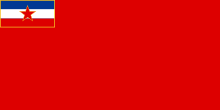 Flag of SR Bosnia and Herzegovina |
 Flag of SR Croatia |
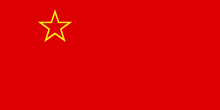 Flag of SR Macedonia |
 Flag of SR Montenegro |
 Flag of SR Serbia |
 Flag of SR Slovenia |
History
Kingdom of Yugoslavia
 | |
| Use |
Civil and state ensign |
|---|---|
| Proportion | 2:3 |
| Adopted | 1918 |
| Design | Three equal horizontal bands of blue (top), white and red |
|
Variant flag of Kingdom of Yugoslavia | |
| Use |
National flag |
| Proportion | 2:3 |
|
Variant flag of Kingdom of Yugoslavia | |
| Use |
War flag |
| Proportion | 2:3 |
| Adopted | 1922 |
| Design | Three equal horizontal bands of blue (top), white and red, with coat of arms near the staff side of the flag |
The national flag of the former Kingdom of Yugoslavia was blue-white-red in the horizontal sense against a vertical staff.[5] The common national civil flag was the same as historic Pan-Slavic flag approved at the Pan-Slavic Congress in Prague, 1848.
The naval ensign (war flag) of the Kingdom of Yugoslavia is blue-white-red with the simplified lesser coat of arms: On one third of the ensign length there shall be the state coat of arms with the crown. The height of the arms and crown (without the globe and cross) shall be half of the ensign height.[6][7]
The flags of the Kingdom were in official use from 1922 until the Kingdom of Yugoslavia was occupied by Axis powers in 1941. After that, the flag was used by the officially recognized government in exile, diplomatic representatives, and the Allies until 1945. During the Second World War, Yugoslav Army in the Fatherland (also known as Chetniks) continued to use the flag.
The Kingdom of Serbs, Croats and Slovenes was established on December 1, 1918 and was renamed the Kingdom of Yugoslavia on October 3, 1929. The state's first flag was officially adopted in 1922.[8] All Yugoslav flags (including the first ones) were variations on the Pan-Slavic flag adopted at the Pan-Slavic Congress in Prague in 1848. The Pan-Slavic flag was a plain blue-white-red tricolor in the horizontal sense against a vertical staff, and the national flag and civil and state ensign during the 1918-1943 period (Kingdom of Yugoslavia) was exactly the same.[5] The naval ensign during the period was the blue-white-red tricolor with the simplified lesser coat of arms of Yugoslavia.[6][9]
Banovina of Croatia
In response to demands by Croat politicians for autonomy of Croatia, an autonomous region of Croatia was created within the Kingdom of Yugoslavia, the Banovina of Croatia. It used the Croatian red-white-blue tricolour for its civil flag, and its state flag included the tricolour charged with the Croatian šahovnica.
 Civil flag of the Banovina of Croatia
Civil flag of the Banovina of Croatia .
..svg.png) State flag of the Banovina of Croatia
State flag of the Banovina of Croatia .
.
World War II
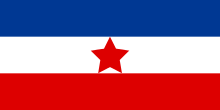
In 1941 during World War II Yugoslavia was invaded and occupied by the Axis powers, and the Yugoslav government fled into exile in London. Soon afterward the Yugoslav resistance, the Partisans, was formed. The Partisans did not support the Yugoslav government-in-exile and initially used a number of different flags until finally one was universally adopted. The new flag was the Yugoslav blue-white-red tricolor with a red star occupying the center of the white field, and with the dimensions altered to 1:2 instead of 2:3. The Partisans were recognized by the Allies in late November 1943 (Tehran Conference) and the name of the Yugoslav state was altered to Democratic Federal Yugoslavia (DFY). The old flag continued to be used by the government-in-exile (up until its merge with the Partisan government, the NKOJ in 1944), by its diplomatic representatives, and by the western Allies until 1945 - while in Yugoslavia, the version with the red star was primarily in use.
Socialist Yugoslavia
After the war, in 1945, the red star flag became universally official. It was given its final shape by enlarging the star and adding a narrow yellow border. The flag was usually accompanied on official buildings by the flag of the federal republic and the flag of the League of Communists of Yugoslavia. Because of this, many buildings in former Yugoslavia still carry a three-poled flag holder. A smaller version of the flag served as the civil ensign while an elongated banner version was seen flown in front of the Yugoslav parliament.
Construction details
Chapter 1, Article 4 of the 1946 Yugoslav Constitution laid out the specifications for the SFRY flag. The ratio was set at 1:2 and it consisted of a flag that has blue, white and red horizontal stripes that are of equal width. In the middle of the flag is a red star that has a border of golden-yellow. The red star is placed in the center of the flag where the intersections of the corners meet.[10] In the 1963 and 1974 constitutions, the specifications and design of the flag did not change. Other sources state that the red star is placed in a circle that has a diameter of 2⁄3 of the flag's hoist (width). The size of the golden-yellow border was not defined in the 1946 Constitution.[11]
See also
References
- ↑ http://public.carnet.hr/fame/home.html
- ↑ http://public.carnet.hr/fame/home.html
- ↑ http://public.carnet.hr/fame/home.html
- ↑ Prague Slavic Congress, 1848
- 1 2 The Constitution of the Kingdom of Yugoslavia
- 1 2 The Law on the Ensigns of War, Merchant and Private Vessels from 1922.
- ↑ Law on the Flags of Yugoslav Ships from 1937.
- ↑ Službene Novine Kraljevine Srba, Hrvata i Slovenaca, broj 89/1922, 28. 02. 1922.
- ↑ Law on the Flags of Yugoslavian Ships from 1937.
- ↑ s:Устав Федеративне Народне Републике Југославије (1946)
- ↑ http://zeljko-heimer-fame.from.hr/descr/yu-fnrj1.html#yu%271946
External links
| Wikimedia Commons has media related to Flags of Yugoslavia. |

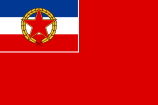
.svg.png)
